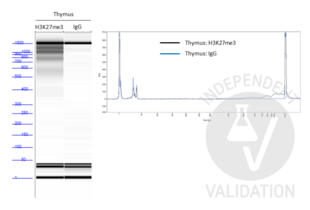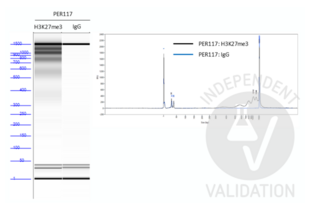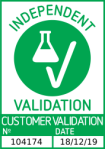Meerschweinchen anti-Kaninchen IgG (Heavy & Light Chain) Antikörper - Preadsorbed
-
- Highlights
-
- 95+ publication references, 1 independent validation
- Frequently used as CUT&RUN IgG negative control and CUT&Tag secondary antibody
- Used in CUT&RUN and CUT&Tag protocols, e.g. Henikoff et al. (2018) PMID 29651053, Kaya-Okur et al. (2019, 2020) PMID 31036827 and PMID 32913232
- Target Alle IgG Produkte
- IgG
-
Bindungsspezifität
- Heavy & Light Chain
-
Reaktivität
- Kaninchen
-
Wirt
- Meerschweinchen
-
Klonalität
- Polyklonal
-
Applikation
- ELISA, Immunohistochemistry (IHC), Western Blotting (WB), Cleavage Under Targets and Tagmentation (CUT&Tag), Cleavage Under Targets and Release Using Nuclease (CUT&RUN)
- Verwendungszweck
-
The Guinea Pig anti-Rabbit IgG antibody ABIN101961 is well suited as a CUT&RUN IgG negative control and as a secondary antibody in CUT&Tag. It is a component of all our CUT&RUN Product Sets.
Find more products for CUT&RUN and CUT&Tag:
- Spezifität
- Rabbit IgG (H&L)
- Kreuzreaktivität (Details)
- No reaction was observed against Human, Mouse and Goat Serum Proteins.
- Aufreinigung
- Preadsorption: Solid phase absorption
- Sterilität
- Sterile filtered
- Immunogen
- whole molecule of rabbit IgG
- Isotyp
- IgG
-
-
- Applikationshinweise
-
The guinea pig anti-rabbit IgG antibody ABIN101961 is suitable for use in ELISA, immunohistochemistry, and Western Blot, CUT&RUN and CUT&Tag. Specific conditions for each assay should be optimized by the end user. General ABIN101961 dilution recommendations for different applications are as follows:
- ELISA: 1:20,000 - 1:100,000
- WB: 1:2,000 - 1:10,000
- IHC: 1:1,000 - 1:5,000
- CUT&RUN: 1:100
- CUT&Tag: 1:100
- Kommentare
-
ABIN101961 is tested via ELISA to ensure that the titer against the antigen (Rb IgG) is above a certain threshold. We also test to make sure the titer against potentially cross-reactive human IgG, goat IgG, and mouse IgG is below a certain threshold.
In addition, we test ABIN101961 against anti-guinea pig Serum, rabbit IgG, and rabbit serum in an immunoelectrophoresis assay. - Beschränkungen
- Nur für Forschungszwecke einsetzbar
-
- by
- Tom Taghon’s lab, Vakgroep Diagnostische Wetenschappen, Universiteit Gent
- No.
- #104174
- Datum
- 18.12.2019
- Antigen
- rabbit IgG
- Chargennummer
- 43586
- Validierte Anwendung
- Cleavage Under Targets and Tagmentation
- Positivkontrolle
rabbit anti-H3K27me3 monoclonal antibody
- Negativkontrolle
rabbit normal IgG antibody
- Bewertung
Passed. ABIN101961 successfully increased the number of protein A binding sites in a CUT&Tag protocol on human primary thymocytes and PER-117 cells using a monoclonal rabbit H3K27me3 primary antibody.
- Primärantikörper
- rabbit IgG anti-H3K27me3 antibody (Cell Signaling Technology, 9733T, lot 14)
- Sekundärantikörper
- ABIN101961
- Full Protocol
- Profiling of H3K27me3 signals in human primary CD34+ sorted thymocytes and PER-117 cell line (50,000 cells each).
- Carry out the CUT&Tag protocol according to the single-tube bench top protocol for CUT&Tag developed by Steven Henikoff’s lab as outlined on the protocols.io platform.
- Use reagents as suggested in the original protocol. The pA-Tn5 fusion protein used in this validation was a courtesy of Steven Henikoff’s lab and used at 1:1000 dilution for 100 µL per sample.
- Primary antibody binding with
- 1µl/sample monoclonal rabbit IgG anti-H3K27me3 antibody (Cell Signaling Technology, 9733T, lot 14) or
- 1µl/sample rabbit normal IgG (Cell Signaling, 2729S, lot 9).
- Secondary antibody binding with 1µl/sample guinea pig anti rabbit antibody (antibodies-online, ABIN101961, lot 43586).
- Determine library concentration on a Qubit Fluorometer using Qubit dsDNA High Sensitivity Assay Kit (ThermoFisher Scientific, Q32581).
- Determine library size distribution of all samples on an Agilent Fragment Analyzer using High Sensitivity Small DNA Fragment Analysis Kit (Agilent, DNF-477-0500).
- Anmerkungen
ABIN101961 successfully increased the number of protein A binding sites for each bound rabbit anti-H3K27me3 antibody in the human primary thymocytes and PER-117 cell line. This resulted in quantifiable amounts of tagmented genomic fragments after PCR amplification that showed a ladder-like distribution.
- Library concentrations as measured on a Qubit Fluorometer were 0.122ng/µl and 0.538ng/µl for thymocytes and PER-117 cells respectively using a rabbit H3K27me3 primary antibody. Library concentration for both sample was below the instrument’s detections limit using the rabbit normal IgG primary antibody.
- As discussed at the protocols.io, it is expected to observe a ladder-like distribution for H3K27me3 profiling. However, using lower cell numbers could alter the nucleosomal patterns and result in an increase in larger fragments. This is observed by Steven Henikoff’s lab as well. Nevertheless, it does not affect the quality of the sequencing results.
Validierung #104174 (Cleavage Under Targets and Tagmentation)![Erfolgreich validiert 'Independent Validation' Siegel]()
![Erfolgreich validiert 'Independent Validation' Siegel]() ValidierungsbilderProtokoll
ValidierungsbilderProtokoll -
- Format
- Liquid
- Konzentration
- 1.21 mg/mL
- Buffer
- 0.02 M Potassium Phosphate, 0.15 M Sodium Chloride, pH 7.2, 0.01 % (w/v) NaN3, no stabilizer
- Konservierungsmittel
- Sodium azide
- Vorsichtsmaßnahmen
- This product contains Sodium azide: a POISONOUS AND HAZARDOUS SUBSTANCE which should be handled by trained staff only.
- Lagerung
- 4 °C,-20 °C
- Haltbarkeit
- 12 months
-
-
: "Chem-map profiles drug binding to chromatin in cells." in: Nature biotechnology, (2023) (PubMed).
: "The ETS transcription factor ETV6 constrains the transcriptional activity of EWS-FLI to promote Ewing sarcoma." in: Nature cell biology, Vol. 25, Issue 2, pp. 285-297, (2023) (PubMed).
: "Histone remodeling reflects conserved mechanisms of bovine and human preimplantation development." in: EMBO reports, Vol. 24, Issue 3, pp. e55726, (2023) (PubMed).
: "The Hdc GC box is critical for Hdc gene transcription and histamine-mediated anaphylaxis." in: The Journal of allergy and clinical immunology, (2023) (PubMed).
: "Loss of MLL3/4 decouples enhancer H3K4 monomethylation, H3K27 acetylation, and gene activation during embryonic stem cell differentiation." in: Genome biology, Vol. 24, Issue 1, pp. 41, (2023) (PubMed).
: "An integrative epigenomic approach identifies ELF3 as an oncogenic regulator in ASCL1-positive neuroendocrine carcinoma" in: Cancer Science, (2023) (PubMed).
: "Transcriptional-translational conflict is a barrier to cellular transformation and cancer progression." in: Cancer cell, (2023) (PubMed).
: "Heat shock transcription factors demonstrate a distinct mode of interaction with mitotic chromosomes." in: Nucleic acids research, (2023) (PubMed).
: "BIND&MODIFY: a long-range method for single-molecule mapping of chromatin modifications in eukaryotes." in: Genome biology, Vol. 24, Issue 1, pp. 61, (2023) (PubMed).
: "Combinatory EHMT and PARP inhibition induces an interferon response and a CD8 T cell-dependent tumor regression in PARP inhibitor-resistant models." in: bioRxiv : the preprint server for biology, (2023) (PubMed).
: "Engineered MED12 mutations drive uterine fibroid-like transcriptional and metabolic programs by altering the 3D genome compartmentalization." in: Research square, (2023) (PubMed).
: "RNA Polymerase II, the BAF remodeler and transcription factors synergize to evict nucleosomes." in: bioRxiv : the preprint server for biology, (2023) (PubMed).
: "Analyzing the Genome-Wide Distribution of Histone Marks by CUT&Tag in Drosophila Embryos." in: Methods in molecular biology (Clifton, N.J.), Vol. 2655, pp. 1-17, (2023) (PubMed).
: "DNA selection by the master transcription factor PU.1." in: Cell reports, Vol. 42, Issue 7, pp. 112671, (2023) (PubMed).
: "Cancer lineage-specific regulation of YAP responsive elements revealed through large-scale functional epigenomic screens." in: Nature communications, Vol. 14, Issue 1, pp. 3907, (2023) (PubMed).
: "Engineered MED12 mutations drive leiomyoma-like transcriptional and metabolic programs by altering the 3D genome compartmentalization." in: Nature communications, Vol. 14, Issue 1, pp. 4057, (2023) (PubMed).
: "Tet2 regulates Sin3a recruitment at active enhancers in embryonic stem cells." in: iScience, Vol. 26, Issue 7, pp. 107170, (2023) (PubMed).
: "Context-defined cancer co-dependency mapping identifies a functional interplay between PRC2 and MLL-MEN1 complex in lymphoma." in: Nature communications, Vol. 14, Issue 1, pp. 4259, (2023) (PubMed).
: "H3K36 methylation maintains cell identity by regulating opposing lineage programmes." in: Nature cell biology, Vol. 25, Issue 8, pp. 1121-1134, (2023) (PubMed).
: "PLA2G2E-mediated lipid metabolism triggers brain-autonomous neural repair after ischemic stroke." in: Neuron, (2023) (PubMed).
-
: "Chem-map profiles drug binding to chromatin in cells." in: Nature biotechnology, (2023) (PubMed).
-
- Target
- IgG
- Abstract
- IgG Produkte
- Substanzklasse
- Antibody
-



 (105 Referenzen)
(105 Referenzen) (1 Validierung)
(1 Validierung)



